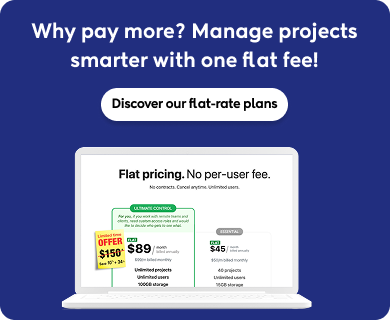Introduction
It is not difficult to understand the project objectives or goals you want to achieve from a project. The real challenge is effectively defining and using these objectives to guide your project to success.
Just take an example, you say, my project objective is: I want to improve customer experience. And you randomly start making changes that come to your mind. Will that work? The answer is a Big No.
To make a lasting impact, you need a well-defined project objective. For that,
- First, you need to find out the areas you need improvement.
- Access how you are currently performing.
- And articulate what you have to do to achieve your goals.
In this article, you’ll learn how to set clear and achievable project objectives using the SMART method, with practical tips and examples to help you manage your projects effectively.
What are project objectives?
Project objectives state what you want to accomplish from a project. A project can have only one objective or multiple objectives with the purpose of achieving the project goal.
These objectives detail specific and measurable outcomes of a project. They can be tangible, such as delivering a physical product, or intangible, such as enhancing productivity.
The beauty of project objectives is they communicate intangible objectives in measurable terms. That’s why it has to be quantified and measurable.
Types of project objectives
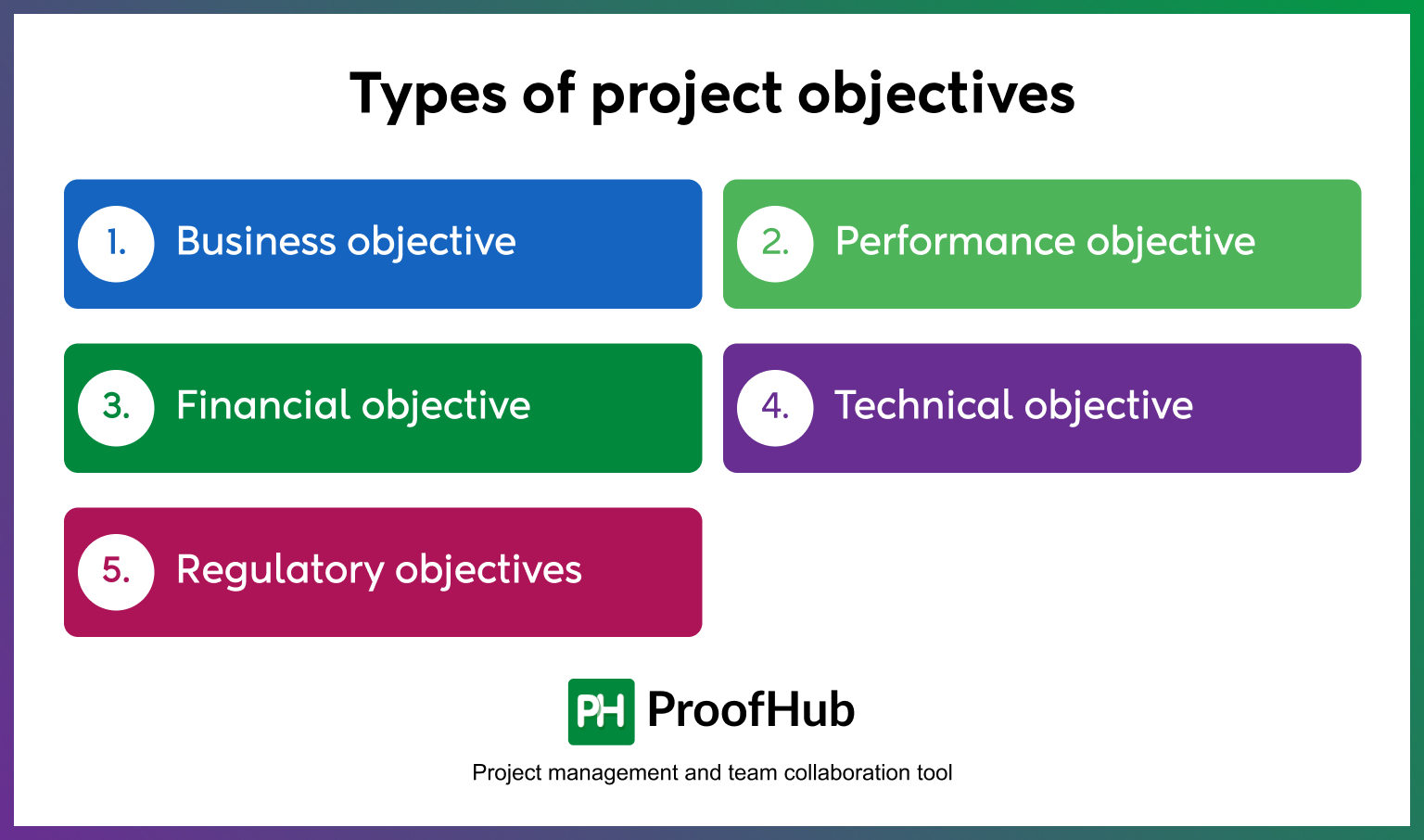
There is no standard categorization of project objectives. Project objectives can be identified based on the job function or the purpose of the project. However, the common types of project objectives include:
1. Business objective
It talks about what you want to achieve for your business. It can be launching a new product or service, launching an existing product to a new market, or simply branding your business as an industry leader. Clearly defining what you want to do helps you plan a project, manage risks, and allocate resources better.
2. Performance objective
It focuses on improving the performance of products, services, people, or processes. The focus is to analyze the current process, find areas of improvement, and define actionable steps to make improvements. It can include the quality of the product, employee performance, process efficiency, or service delivery.
3. Financial objective
It talks about the objectives you have for the finances of your company. It can be seeking investment for expansion, creating backups, reducing cost, or increasing profit margins.
4. Technical objective
It talks about adopting new technology to upgrade your current technology systems. Especially in the modern time of remote work and distributed teams, many companies are going through a technological transformation for smooth functioning.
5. Regulatory objectives
It talks about the regulatory requirements of a project so that your product or service is within the government or industry standard regulation. Meeting regulatory objectives ensures that project manager goals are met while adhering to legal and industry standards.
Now, we have learned the importance and types of project objectives. Let’s learn how to write them.
Importance of project objectives
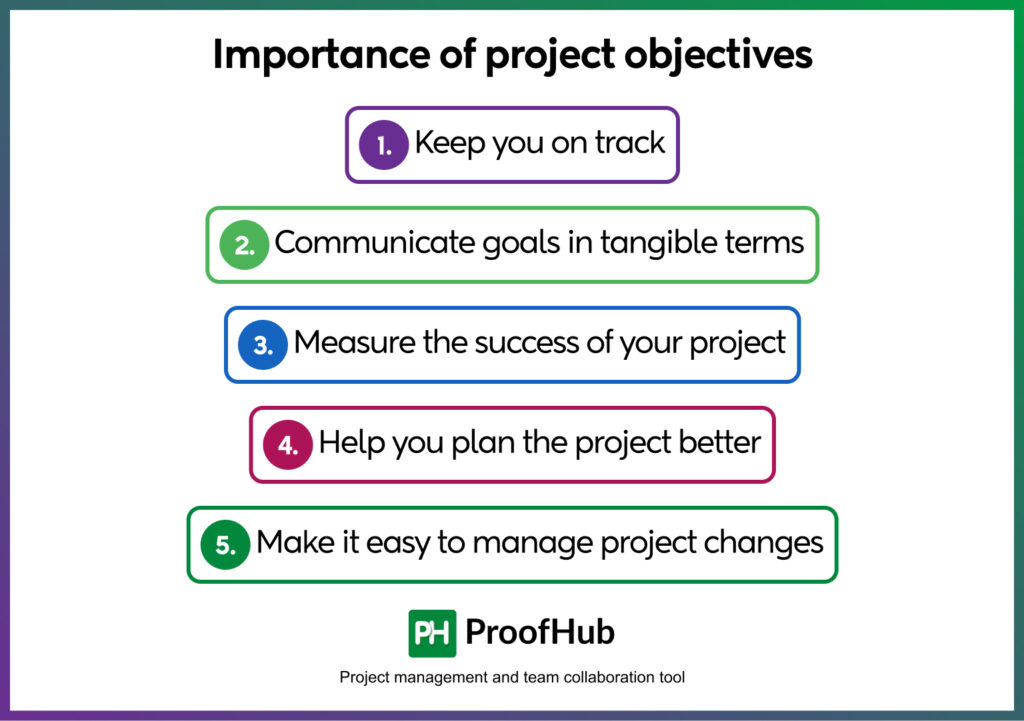
Project objectives are guidelines that direct you to the key results of the project and help you measure the project’s success. Here is how project objectives can enhance your project:
1. Keep you on track
A clear project objective defines the aim of the project. Thus, it prevents you and your team from going off track and impacts every decision in the project’s lifespan. You can direct your team throughout the project lifespan.
2. Communicate goals in tangible terms
Project objectives define goals in measurable terms. This makes it easy for you to communicate the impact of project objectives and teams to understand the project requirements and their impact on the overall success of the project.
3. Measure the success of your project
Project objectives provide you with benchmarks to measure the success of your project. It provides you with predefined criteria such as budget, time, and a measurable goal to evaluate your project performance, make comparisons, and define success.
4. Help you plan the project better
When you have a clear idea of what you want to achieve through the project and the resources you have at your disposal, it helps you plan your project and resources to maximum efficiency.
5. Make it easy to manage project changes
Sometimes you have to make changes in project objectives due to situational changes, project objectives make it easy to implement the changes as you are constantly evaluating the progress with key milestones.
How to write effective project objectives using the SMART framework?
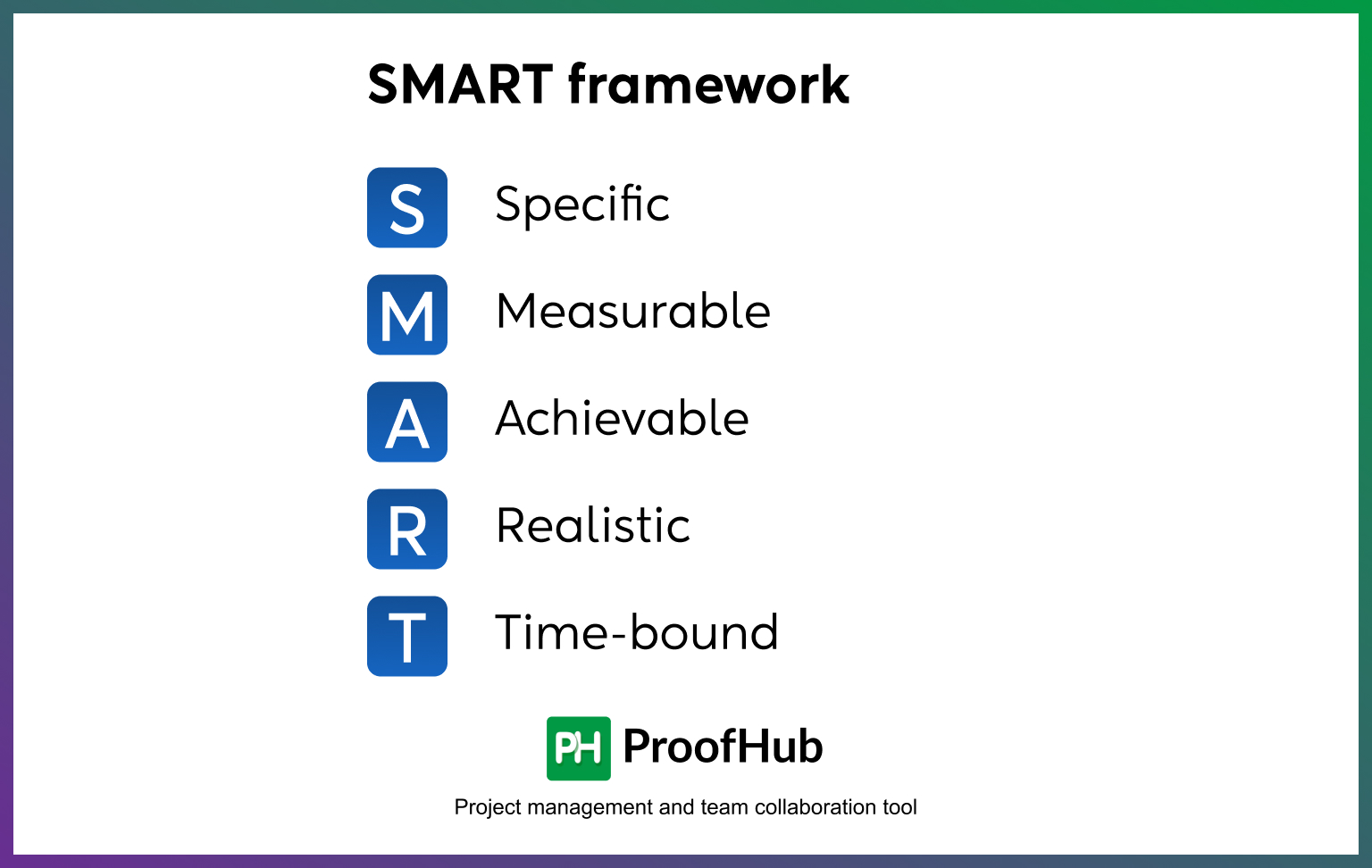
Writing an effective project objective is an art. Key qualities of a good project objective are that it is measurable, time-bound, well-defined, achievable, and realistic. That’s what the SMART framework is all about.
1. Specific
A project objective should be specific and adhere to project goals. It should not have a broad or unclear objective to serve. It should clearly define what specific outcome you want to achieve from your project.
For example, I want to improve customer experience. This is not a good written project objective because it does not specify what areas you want to work on.
I want to reduce the time needed to help customers with an issue in order to improve customer experience. This is a well-written project objective because it provides directions on what to work on.
2. Measurable
A project objective should be measurable so that you know to what extent you need to work. To quantify a project objective, you need to add some measurable element to it such as a number, a percent change, etc.
For example, I want to reduce the time needed to help customers with an issue by 30% to improve customer experience.
The quantifiable element of ‘30%’ makes the project objective measurable, makes it easy to track progress, and helps you measure success.
Similarly, you can set various KPIs as benchmarks to measure the overall success of the project.
3. Achievable
A project objective should be within the realm of the possibility of achieving. There is no point in setting a project objective that is not achievable because no matter what you do, you will not be able to achieve it.
To do so, ask yourself a question, is it possible to achieve the goals you are setting?
4. Realistic
A possibility does not mean reality. You need to ensure the project objective is practical and within the scope of your project and team to accomplish. Because there is no point in setting unrealistic objectives that your team cannot achieve.
To do so, ask yourself these questions while writing the project objective:
- How many resources do you have for this?
- How much time can your team devote?
- How much budget do you have for this?
Based on the answers, set an attainable project objective.
5. Time-bound
A project objective should have a deadline because without that it is hard to define when a project should end. You might end up continuing to make efforts for an unreasonable long time and end up with unprofitable results.
For example, you can write, I want to reduce the time needed to help a customer with issues by 30% to improve customer experience by the end of this quarter.
This time element gives you a timeline and suggests resource requirements to achieve the project objective.
5 Best practices for establishing effective project objectives
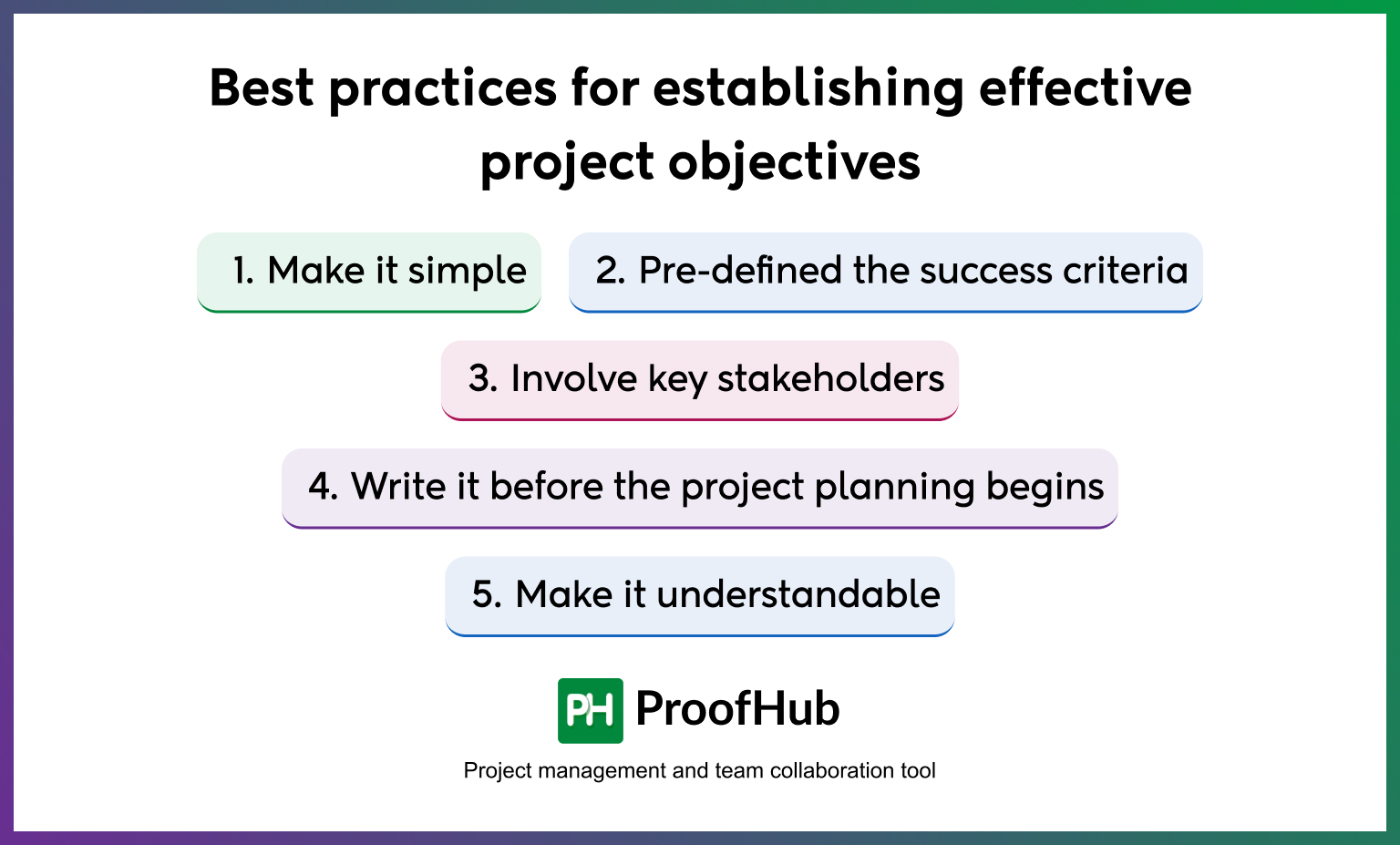
The purpose of the project objective is to clearly define the aim of the project or what you want to achieve from the project. Not to define how something is done, it is reserved for project plans. Here are the five best practices to write an effective project objective:
1. Make it simple
Keep it brief, a one-sentence statement, defining what you aim to achieve in measurable terms so that it does not create confusion. Do not provide broad and unclear objectives.
2. Pre-defined the success criteria
Use specific numbers so that team members know what they are aiming for. Providing a range of target numbers creates confusion.
3. Involve key stakeholders
Involve project managers, internal stakeholders, and team members while writing project objectives. It helps everyone to align with the objective and understand its value.
4. Write it before the project planning begins
Write the project objective before the project planning so that you plan the project’s resources, budget, and time accordingly.
5. Make it understandable
Use plain and simple language so that you can easily convey the message to every team member.
Read more: Project management basics: Steps to create a perfect project plan
Examples of project objectives
Example A: Reduce the time wasted on finding documents
I want to reduce the time wasted on finding documents by 20% using a centralized document management system by the end of this quarter.
- Specific: Using a document management system to find documents easily.
- Measurable: We are currently spending an average of 2 hours on finding documents across multiple platforms.
- Achievable: The document management system reduces the time spent on finding documents by bringing and organizing them to a centralized place (as confirmed by SignHouse).
- Realistic: Currently, we do not have a centralized document management system.
- Time-bound: It will take 3 months for the entire team to properly adapt the software and work efficiently.
This is a well-defined project objective that aligns with strategic management principles by being realistic, time-bound, measurable, attainable, and clearly defined with its impact.
Example B: Reducing the average response time
Reducing the average response time by email to all customers to 25% within three months by adding more customer support executives
- Specific: Adding more customer support executives to reduce average response time.
- Measurable: Comparing the current metrics with the target KPIs.
- Achievable: The addition of new resources will reduce the burden on the team.
- Realistic: We have a budget to hire new resources and improve customer experience to help us retain customers.
- Time-bound: We need three months to hire and train new executives.
Example C: Increase the lead generation
Increase the lead generation on LinkedIn by 20% using organic social media marketing in six months with dedicated resources spending half of their work time on LinkedIn.
- Specific: Social media marketing on LinkedIn to increase lead generation (as confirmed by SproutSocial).
- Measurable: Growing the lead generation by 20% compared with current metrics.
- Achievable: We are not active on LinkedIn. We can use the potential audience.
- Realistic: We have resources and skilled workers who can work on it.
- Time-bound: The objective can be achieved in six months.
Write your project objectives well with ProofHub
Writing a project objective requires project knowledge, a SMART framework, and the participation of key stakeholders to make it successful. That’s why it is worth using project management software to write project objectives and create a project plan.
ProofHub helps you write effective project objectives by providing a centralized and transparent platform for all the stakeholders to come together to participate in project discussions.
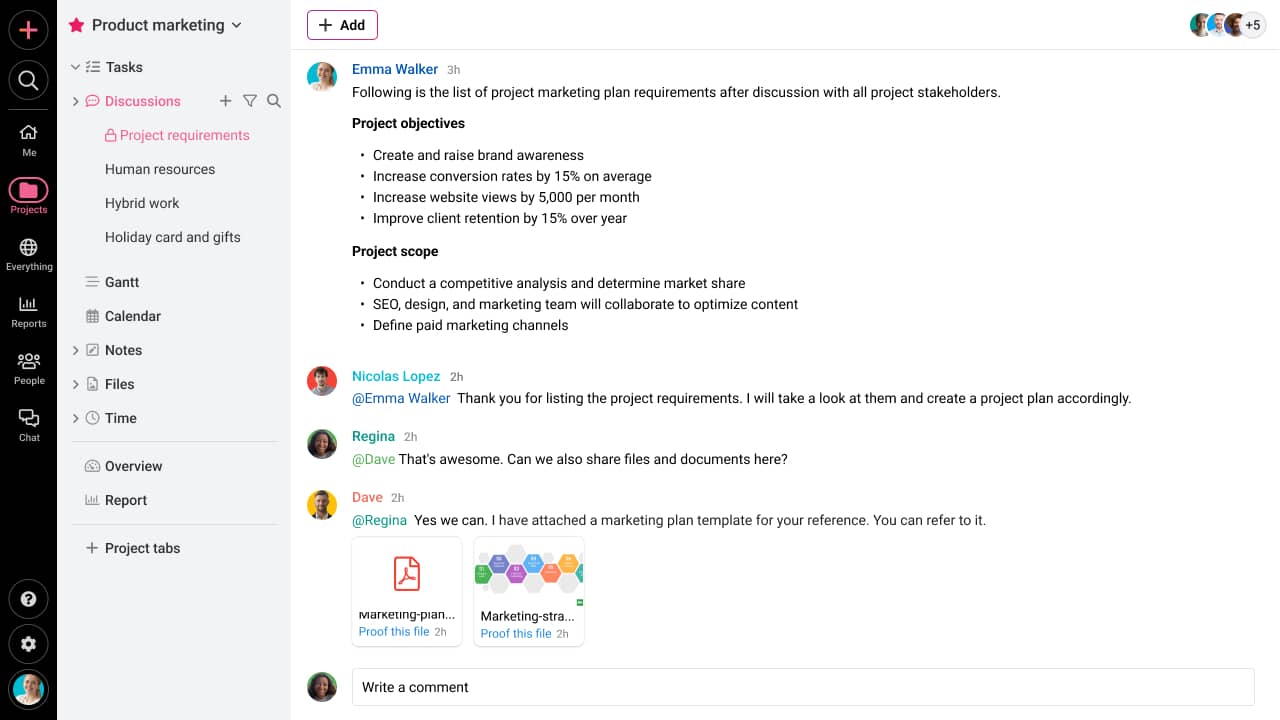
You can also create a roadmap for the project aligned with the project objectives using workflows and implement the very project plan in the same system.
In addition, with ProofHub you can prioritize the objectives based on their importance. Once objectives are selected, break them down into smaller manageable tasks.
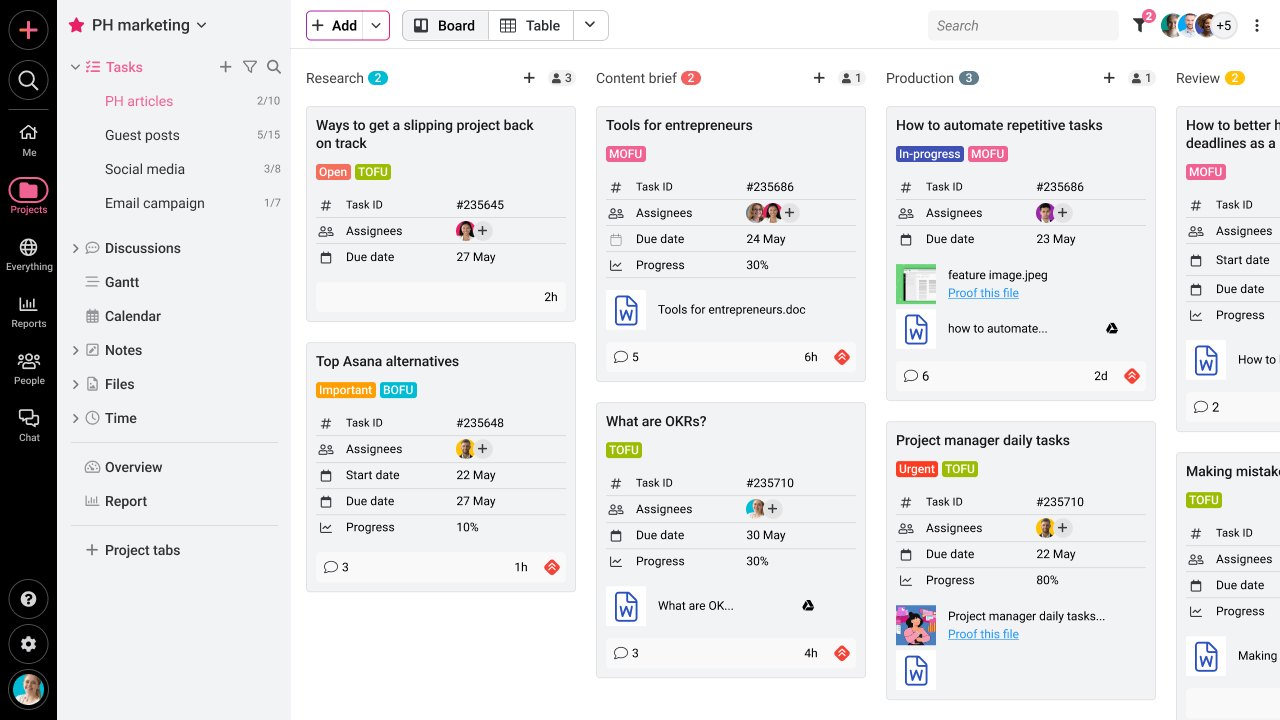
Track and review project objectives progress and make changes on the go to stay aligned with your project management goals.
Conclusion
Writing clear and specific project objectives is crucial for effective project management. With the help of the tips shared in this article, you can make sure that your objectives are SMART, achievable, and aligned with your project goals.
To further enhance your project management process teams can use ProofHub. It breaks down your objectives into detailed tasks and subtasks and assigns them to team members.
Also, ProofHub’s discussion boards facilitate team conversations and encourage team members to share ideas and provide feedback.
Related articles
- What is project quality management?
- 28 Project management skills a project manager must have
- 9 Project management mistakes a project manager should avoid (With solutions)
- Top 10 reasons why projects fail (and their solution)
- Common project management challenges & their solutions
FAQs
What is the difference between project objectives and project goals?
Project objectives are measurable, practical, and short-term outcomes leading to generally broad and long-term project goals. Whereas, project goals are at a higher level than project objectives.
What is the difference between project objectives and business objectives?
Project objectives are restricted only to the project. They are specific with a focus on project outcomes. At the same time, business objectives are bigger than a single project. A project objective should be in alignment with business objectives.
What is the difference between project objectives and project plan?
Project objectives define what you want to achieve from a project whereas a project plan is a blueprint that defines how you will achieve your project goals and objectives.
What is the difference between project objectives and project milestones?
Project objectives are the overall outcomes of a project whereas project milestones are specific checkpoints that help you measure the progress of the project and ensure goals are achieved within the project timeline.
What are the key deliverables in a project?
Key deliverables of a project are the expected outcomes of a project. It can be tangible such as a physical app or intangible such as improved productivity.

